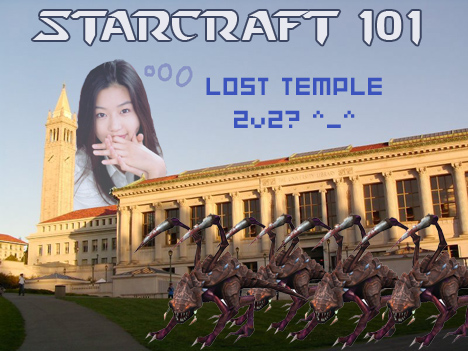There’s been a lot of talk recently about UC Berkeley’s class on Starcraft. Seems many people are blown away that a school as well-known as Cal would be giving units for playing a ten-year-old computer game. I mean, seems pretty insane. What has American academia come to? Teaching people how to play Starcraft??
So I got a little curious about this whole endeavor. I mean, as a Cal student myself, what does a class on Starcraft mean for the students taking it? So Thursday night, I walked across campus, entered the building where the class was taking place, and prepared myself for the experience.
The first thing to greet my vision? Well, that would be the line of nerdy guys (and, I’ll be honest, a lot of Asian students) with laptops sitting outside the classroom. That’s when I knew I was in for a pretty hardcore night of Starcraft.
Hit the jump for my learning experience.
Now, let’s be clear: the Starcraft course is not quite what it seems. Yeah, this is a course on Starcraft, but no, it’s not a “real” class in the traditional sense. The course is what Berkeley calls a “DeCal,” which is their hippie method of “democratic education.” Hell, you can only take the class pass/no pass, and the units don’t even apply to your general GPA.
Basically, Starcraft DeCal 2009 (as it is officially called) is a two unit course taught by two of my fellow undergrads, Alan Feng and Sherwin Mahbod. While this might sound disappointing to some, the reality is that Starcraft is taught by two really dedicated guys who want to bring an academic flair to teaching people how to play this game. An attitude like that is pretty refreshing, even if all I’m learning is the latest method of the Zerg Rush.
Anyway, settling down in the back of the class, I knew things would be interesting. Although I have never played Starcraft and didn’t quite know what exactly was going on, seeing forty or so other people in a classroom genuinely excited for what they were learning was fantastic. When Alan and Sherwin would ask questions about units size or resource costs, people would be quick to offer a response. Armor stats were discussed, animation frames were valid question topics, the comparison between “low game” and “high game” play-styles were made, and even comparisons to Super Smash Bros. Melee was OK for our education.
While watching YouTube clips of “high game” level Koreans doing insane stuff with their units, you could tell every single person in the room was glued to the screen. And when something cool would happen? The whole class would erupt into loud cheers.
I’ve never seen that in my Modern American Literature class.

While the content of the course is amazingly fun (I mean, ultimately you’re gonna be graded on how well you play a videogame), just as interesting were the people who were there. Obviously, there were hordes of college males, and even a few of their girlfriends. However, there were plenty people just curious like myself.
For example, there were two Berkeley graduate students who were applying A.I. to robotics, and were looking to learn more on human intelligence as applied to real-time strategy games. My response to them was a slightly dropped jaw, and an appreciation for Engineering majors. They just smiled and walked on.
Others who showed up were students from other schools who had heard about this course from videogame and fan Web sites. I know of one guys who drove two hours from San Jose just to sit in on a Starcraft course, even though he already knew most of the stuff. His buddy, a recent Berkeley graduate himself, was willing to come back to Berkeley to see this class.
Even the Starcraft community came out in support for the class. Two guys who only introduced themselves as Noah and Christian are actually very active members of Starcraft fan sites. Noah even provides the English commentary on some of the Starcraft videos on YouTube, and he had driven almost 100 miles just to support the class.
I’ve got to say, even though this class isn’t taught by paid faculty, these people are about as professional as it ges.
So while I don’t see myself actually signing up for the course (I mean, my courses on Firefly and High-Elvish have conflicting schedules), I am blown away by what Alan and Sherwin have done. While games have a long ways to go before they are being taught like a film studies course, this DeCal is a great step in the right direction.
So when can I take a class on Musicianship and Rock Band, huh?


